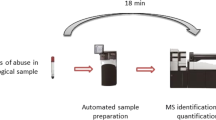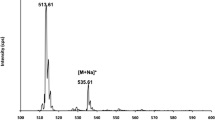Abstract
A liquid chromatographic–tandem mass spectrometric (LC–MS/MS) method was developed and applied for the determination of human Aβ1-40 and Aβ1-42 peptides in transgenic mouse plasma to support preclinical pharmacodynamics studies. The method consisted of micro-elution solid phase extraction for sample preparation and LC–MS/MS analysis in the negative ion mode using electrospray ionization for analysis. 15N53-Aβ1-40 and 15N55-Aβ1-42 peptides were used as internal standards. A quadratic regression (weighted 1/concentrations), with an equation y = ax 2 + bx + c, was used to fit calibration curves over the concentration range of 0.500–100 ng/mL for both Aβ1-40 and Aβ1-42 peptides. For quality control samples at 6.00, 40.0 and 80.0 ng/mL from the qualification experiment, the within-run accuracy ranged from −2.69 to 0.583 % with precision values ≤8.23 % for Aβ1-40. Within-run accuracy ranged from −4.83 to 10.1 % with precision values ≤8.87 % for Aβ1-42. Samples from a pharmacodynamics study using Tg2576 transgenic mice were analyzed by this qualified LC–MS/MS method and concentrations were compared to those generated by ELISA. The two methods were shown to be comparable for Aβ1-40 quantification of samples from the Tg2576 amyloid precursor protein transgenic mouse model, but varied slightly for Aβ1-42.



Similar content being viewed by others
References
Brookmeyer, R., E. Johnson, K. Ziegler-Grahm, and H.M. Arrighi. 2007. Forecasting the global burden of Alzheimer’s disease. Alzheimers Dement 3: 186–191.
Cantone, J.L., A. Xu-Lin, J.H. Toyn, and D.M. Drexler. 2009. Application of quantitative LC–MS surrogate peptide methodology in the analysis of the amyloid beta peptide biosynthetic intermediate protein APP-betaCTF. Journal of Neuroscience Methods 180: 255–260.
Chen, X.G., S.K. Brining, V.Q. Nguyen, and A.L. Yergey. 1997. Simultaneous assessment of conformation and aggregation of beta-amyloid peptide using electrospray ionization mass spectrometry. FASEB Journal 11: 817–823.
Cheng, X., and R.B. van Breemen. 2005. Mass spectrometry-based screening for inhibitors of beta-amyloid protein aggregation. Analytical Chemistry 77: 7012–7015.
Clarke, N.J., A.J. Tomlinson, Y. Ohyagi, S. Younkin, and S. Naylor. 1998. Detection and quantitation of cellularly derived amyloid beta peptides by immunoprecipitation-HPLC-MS. FEBS Letters 430: 419–423.
Cummings, J.L. 2004. Alzheimer’s disease. New England Journal of Medicine 351: 56–67.
Du, C., C. Ramaley, H. McLean, S.C. Leonard, and J. Miller. 2005. High performance liquid chromatography coupled with tandem mass spectrometry for the detection of amyloid beta peptide related to Alzheimer’s disease. Journal of Biomolecular Techniques 16: 354–361.
Glenner, G.G., and C.W. Wong. 1984. Alzheimer’s disease: initial report of the purification and characterization of a novel cerebrovascular amyloid protein. Biochemical and Biophysical Research Communications 120: 1131–1135.
Goda, R., and N. Kobayashi. 2012. Evaluation of peptide adsorption-controlled liquid chromatography–tandem mass spectrometric (PAC–LC–MS/MS) method for simple and simultaneous quantitation of amyloid β 1–38, 1–40, 1–42 and 1–43 peptides in dog cerebrospinal fluid. Journal of Chromatography B 895–896: 137–145.
Gravina, S.A., L. Ho, C.B. Eckman, K.E. Long, L. Otvos Jr, L.H. Younkin, N. Suzuki, and S.G. Youngkin. 1995. Amyloid beta protein in Alzheimer’s disease brain. Biochemical and immunocytochemical analysis with antibodies specific for forms ending at Abeta40 or Abeta42. Journal of Biological Chemistry 270: 7013–7016.
Hardy, J., and D.J. Selkoe. 2002. The amyloid hypothesis of Alzheimer’s disease: progress and problems on the road to therapeutics. Science 297: 353–356.
Hebert, L.E., P.A. Scherr, J.L. Bienias, D.A. Bennett, and D.A. Evans. 2003. Alzheimer disease in the US population: prevalence estimates using the 2000 census. Archives of Neurology 60: 1119–1122.
Hsiao, K. 1998. Transgenic mice expressing Alzheimer amyloid precursor proteins. Experimental Gerontology 33: 883–889.
Inoue, K., M. Kaneko, T. Hino, and H. Oka. 2010. Simple and novel screening assay of natural antioxidants for Cu(II) ion/adrenaline-mediated oxidation of N-terminal amyloid beta by liquid chromatography/mass spectrometry. Journal of Agriculture and Food Chemistry 58: 9413–9417.
Kawarabayashi, T., L.H. Younkin, T.C. Saido, M. Shoji, K.H. Ashe, and S.G. Younkin. 2001. Age-dependent changes in brain, CSF and plasma amyloid (beta) protein in the Tg2576 transgenic mouse model of Alzheimer’s disease. Journal of Neuroscience 21: 372–381.
Kuo, Y.M., T.A. Kokjohn, W. Kalback, D. Luehrs, D.R. Galasko, N. Chevallier, E.H. Koo, M.R. Emmerling, and A.E. Roher. 2000. Amyloid-beta peptides interact with plasma proteins and erythrocytes: implications for their quantification in plasma. Biochemical and Biophysical Research Communications 268: 750–756.
Laird, F.M., H. Cai, A.V. Savonenko, M.H. Farah, K. He, T. Melnikova, H. Wen, H.C. Chiang, G. Xu, V.E. Koliatsos, D.R. Borchelt, D.L. Price, H.K. Lee, and P.C. Wong. 2005. BACE1, a major determinant of selective vulnerability of the brain to amyloid-beta amyloidogenesis, is essential for cognitive, emotional, and synaptic functions. Journal of Neuroscience 25: 11693–11709.
Lanz, T.A., C.S. Himes, G. Pallante, L. Adams, S. Yamazaki, B. Amore, and K.M. Merchant. 2003. The gamma-secretase inhibitor N The gamma-secretase inhibitor N-[N-(3,5-difluorophenacetyl)-l-alanyl]-S-phenylglycine t-butyl ester reduces A beta levels in vivo in plasma and cerebrospinal fluid in young (plaque-free) and aged (plaque-bearing) Tg2576 mice. Journal of Pharmacology and Experimental Therapeutics 305: 864–871.
Lanz, T.A., and J.B. Schachter. 2006. Demonstration of a common artifact in immunosorbent assays of brain extracts: development of a solid-phase extraction protocol to enable measurement of amyloid-beta from wild-type rodent brain. Journal of Neuroscience Methods 157: 71–81.
Masters, C.L., G. Simms, N.A. Weinman, G. Multhaup, B.L. McDonald, and K. Beyreuther. 1985. Amyloid plaque core protein in Alzheimer disease and Down syndrome. Proceedings of the National Academy of Sciences of the United States of America 82: 4245–4249.
McConlogue, L., M. Buttini, J.P. Anderson, E.F. Brigham, K.S. Chen, S.B. Freedman, D. Games, K. Johnson-Wood, M. Lee, M. Zeller, W. Liu, R. Motter, and S. Sinha. 2007. Partial reduction of BACE1 has dramatic effects on Alzheimer plaque and synaptic pathology in APP transgenic mice. Journal of Biological Chemistry 282: 26326–26334.
Oe, T., B.L. Ackermann, K. Inoue, M.J. Berna, C.O. Garner, V. Gelfanova, R.A. Dean, E.R. Siemers, D.M. Holtzman, M.R. Farlow, and I.A. Blair. 2006. Quantitative analysis of amyloid beta peptides in cerebrospinal fluid of Alzheimer’s disease patients by immunoaffinity purification and stable isotope dilution liquid chromatography/negative electrospray ionization tandem mass spectrometry. Rapid Communications in Mass Spectrometry 20: 3723–3735.
Ohno, M., E.A. Sametsky, L.H. Younkin, H. Oakley, S.G. Younkin, M. Citron, R. Vassar, and J.F. Disterhoft. 2004. BACE1 deficiency rescues memory deficits and cholinergic dysfunction in a mouse model of Alzheimer’s disease. Neuron 41: 27–33.
Portelius, E., A. Westman-Brinkmalm, H. Zetterberg, and K. Blennow. 2006. Determination of beta-Amyloid peptide signatures in cerebrospinal fluid using immunoprecipitation-mass spectrometry. Journal of Proteome Research 5: 1010–1016.
Scheuner, D., C. Eckman, M. Jensen, X. Song, M. Citron, N. Suzuki, T.D. Bird, J. Hardy, M. Hutton, W. Kukull, E. Lason, E. Levy-Lahad, M. Vitanen, E. Peskind, P. Poorkaj, G. Schellenberg, R. Tanzi, W. Wasco, L. Lannfelt, D. Selkoe, and S.G. Youngkin. 1996. Secreted amyloid beta-protein similar to that in the senile plaques of Alzheimer’s disease is increased in vivo by the presenilin 1 and 2 and APP mutations linked to familial Alzheimer’s disease. Nature Medicine 2: 864–870.
Slemmon, J.R., C.L. Painter, S. Nadanaciva, F. Catana, A. Cook, R. Motter, and P. Seubert. 2007. Distribution of Abeta peptide in whole blood. Journal of Chromatography B 846: 24–31.
Tahara, T., K. Usuki, H. Sato, H. Ohashi, H. Morita, H. Tsumura, A. Matsumoto, H. Miyazaki, A. Urabe, and T. Kato. 1996. A sensitive sandwitch ELISA for measuring thrombopoietin in human serum: serum thrombopoietin levels in healthy volunteers and in patients with haemopoietic disorders. British Journal of Haematology 93: 783–788.
Tanzi, R.E., and L. Bertram. 2005. Twenty years of the Alzheimer’s disease amyloid hypothesis: a genetic perspective. Cell 120: 545–555.
Watanabe, K., C. Ishikawa, H. Kuwahara, K. Sato, S. Komuro, N. Nomura, S. Watanabe, and M. Yabuki. 2012. A new methodology for simultaneous quantification of total-Aβ, Aβx-38, Aβx-40, and Aβx-42 by column-switching LC/MS/MS. Analytical and Bioanalytical Chemistry 402: 2033–2042.
Westermann, M.A., D. Cooper-Blacketer, A. Mariash, L. Kotillnek, T. Kawarabayashi, L.H. Younkim, G.A. Carlson, S.G. Younkin, and K.H. Ashe. 2002. The relationship between Abeta and memory in the Tg2576 mouse model of Alzheimer’s disease. Journal of Neuroscience 22: 1858–1867.
Acknowledgments
Authors thank DMPK members at Genentech, Array Biopharma and Intertek-Alta Analytical Laboratory scientists for their support on this project. Authors also specially thank Dr. Marcel Hop for his support, review and comments on this manuscript.
Author information
Authors and Affiliations
Corresponding authors
Rights and permissions
About this article
Cite this article
Shin, Y.G., Hamm, L., Murakami, S. et al. Qualification and application of a liquid chromatography–tandem mass spectrometric method for the determination of human Aβ1-40 and Aβ1-42 peptides in transgenic mouse plasma using micro-elution solid phase extraction. Arch. Pharm. Res. 37, 636–644 (2014). https://doi.org/10.1007/s12272-013-0215-2
Received:
Accepted:
Published:
Issue Date:
DOI: https://doi.org/10.1007/s12272-013-0215-2




